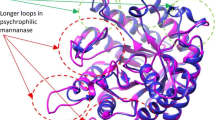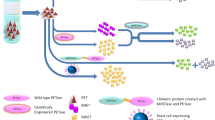Abstract
In this study, we report that the recombinant α subunit chaperonin protein (ApCpnA) from Aeropyrum pernix K1 can efficiently prevent the thermal aggregation and inactivation of foreign model proteins, such as citrate synthase (CS) from= porcine heart, alcohol dehydrogenase (ADH) from Saccharomyces cerevisiae (four 37.5 kDa subunits), and malate dehydrogenase (MDH) from Thermus flavus (two 67 kDa subunits)K=In the presence of ApCpnA and ATP, the thermal aggregation of CS and ADH were prevented by 90 and 65%, respectively, at each 43 and 50°C. Also, the activities of CS, ADH, and MDH under the thermal inactivation conditions were stably maintained at higher than 80% by addition of ApCpnA and ATP, while the activities of those enzymes in the absence of ApCpnA and ATP were dramatically inactivated and decreased below 20% within 30 min. Based on these results, we propose that the α subunit chaperonin from the hyperthermophilic archaeon, A. pernix K1 can be utilized to enhance the durability and cost effectiveness of high-temperature biocatalysts.
Similar content being viewed by others
References
Kim, S., K. R. Willson, and A. L. Horwich (1994) Cytosolic chaperonin subunits have a conserved ATPase domain but diverged polypeptide-binding domains. Trends Biochem. Sci. 19: 543–548.
Mayhew, M., A. C. da Silva, J. Martin, H. Erdjument-Bromage, P. Tempst, and F. U. Hartl (1996) Protein folding in the central cavity of the GroEL-GroES chaperonin complex. Nature 379: 420–426.
Gutsche, I., L. O. Essen, and W. Baumeister (1999) Group II chaperonins: New TRiC(k)s and turns of a protein folding machine. J. Mol. Biol. 293: 295–312.
Kubota, H., G. Hynes, and K. Willson (1995) The chaperonin containing t-complex polypeptide 1(TCP-1) multisubunit machinery assisting in protein folding and assembly in the eukaryotic cytosol. Eur. J. Biochem. 230: 3–16.
Trent, J. D., E. Nimmesgern, J. S. Wall, F. U. Hartl, and A. L. Horwich (1991) A molecular chaperone from a thermophilic archaebacterium is related to the eukaryotic protein t-complex polypeptide-1. Nature 354: 490–493.
Marco, S., D. Ureñ, J. L. Carrascosa, T. Waldmann, J. Peters, R. Hegerl, G. Pfeifer, H. Sack-Kongehl, and W. Baumeister (1994) The molecular chaperone TF55. Assessment of symmetry. FEBS Lett. 341: 152–155.
Pipps, B. M., D. Typke, R. Hegerl, S. Volker, A. Hoffmann, K. O. Stetter, and W. Baumeister (1993) Structure of a molecular chaperone from a thermophilic archaebacterium. Nature 361: 475–477.
Langer, T., G. Pfeifer, J. Martin, W. Baumeister, and F. U. Hartl (1992) Chaperonin mediated protein folding: GroES binds to one end of the GroEL cylinder, which accommodates the protein substrate within its central cavity. EMBO J. 11: 4757–4765.
Yoshida, T., R. Kawaguchi, H. Taguchi, M. Yoshida, T. Yasunaga, T. Wakabayashi, M. Yohda, and T. Maruyama (2002) Archaeal group II chaperonin mediates protein folding in the cis-cavity without a detachable GroES-like co-chaperonin. J. Mol. Biol. 315: 73–85.
Ditzel, L., J. Lowe, D. Stock, K. O. Stetter, H. Huber, R. Huber, and S. Steinbacher (1998) Crystal structure of the thermosome, the archaeal chaperonin and homolog of CCT. Cell 93: 125–138.
Minuth, T., G. Frey, P. Lindner, R. Rachel, K. O. Stetter, and R. Jaenicke (1998) Recombinant homo- and heterooligomers of an ultrastable chaperonin from the archaeon Pyrodictium occultum show chaperone activity in vitro. Eur. J. Biochem. 258: 837–845.
Knapp, S., I. Schhmidt-Krey, H. Hebert, T. Bergman, H. Jornvall, and R. Ladenstein (1994) The molecular chaperonin TF55 from the thermophilic archaeon Sulfolobus solfataricus. A biochemical and structural characterization. J. Mol. Biol. 242: 397–407.
Waldmann, T., E. Nimmesgern, M. Nitsch, J. Peters, G. Pfeifer, S. Muller, J. Kellermann, A. Engel, F. U. Hartl, and W. Baumeister (1995) The thermosome of Thermoplasma acidophilum and its relationship to the eukaryotic chaperonin TRiC. Eur. J. Biochem. 227: 848–856.
Hirai, H., K. Noi, K. Hongo, T. Mizobata, and Y. Kawata (2008) Functional characterization of the recombinant group II chaperonin alpha from Thermoplasma acidophilum. J. Biochem. 143: 505–515.
Andra, S., G. Frey, M. Nitsch, W. Baumeister, and K. O. Stetter (1996) Purification and structural characterization of the thermosome from the hyperthermophilic archaeum Methanopyrus kandleri. FEBS Lett. 379: 127–131.
Minuth, T., M. Henn, K. Rutkat, S. Andr Rachel, K. O. Stetter, and R. Jaenicke (1999) The recombinant thermosome from the hyperthermophilic archaeon Methanopyrus kandleri: in vitro analysis of its chaperone activity. Biol. Chem. 380: 55–62.
Isumi, M., S. Fuiwara, M. Takagi, S. Kanaya, and T. Imanaka (1999) Isolation and characterization of a second subunit of molecular chaperonin from Pyrococcus kodakaraensis KOD1: analysis of an ATPase-deficient mutant enzyme. Appl. Environ. Microbiol. 65: 1801–1805.
Yan, Z., S. Fujiwara, K. Kohda, M. Takagi, and T. Imanaka (1997) In vitro stabilization and in vivo solubilization of foreign proteins by the beta subunit of a chaperonin from the hyperthermophilic archaeon Pyrococcus sp. strain KOD1. Appl. Environ. Microbiol. 63: 785–789.
Yoshida, T., M. Yohda, T. Iida, T. Maruyama, H. Taguchi, K. Yazaki, T. Ohta, M. Odaka, I. Endo, and Y. Kagawa (1997) Structural and functional characterization of homo-oligomeric complexes of alpha and beta chaperonin subunits from the hyperthermophilic archaeum Thermococcus strain KS-1. J. Mol. Biol. 273: 635–645.
Furutani, M., T. Iida, T. Yoshida, and T. Maruyama (1998) Group II chaperonin in a thermophilic methanogen Methanococcus thermolithotrophicus. Chaperone activity and filament-forming ability. J. Biol. Chem. 273: 28399–28407.
Okochi, M., H. Matsuzaki, T. Nomura, N. Ishii, and M. Yohda (2005) Molecular characterization of the group II chaperonin from the hyperthermophilic archaeum Pyrococcus horikoshii OT3. Extremophiles 9: 127–134.
Son, H. J., E. J. Shin, S. W. Nam, D. E. Kim, and S. J. Jeon (2007) Properties of the α subunit of a chaperonin from the hyperthermophilic crenarchaeon Aeropyrum pernix K1. FEMS Microbiol. Lett. 266: 103–109.
Chen, H. Y., Z. M. Chu, Y. H. Ma, Y. Zhang, and S. L. Yang (2007) Expression and characterization of the chaperonin molecular machine from the hyperthermophilic archaeon Pyrococcus furiosus. J. Basic Microbiol. 47: 132–137.
Guagliardi, A., L. Cerchia, S. Bartolucci, and M. Rossi (1994) The chaperonin from the archaeon Sulfolobus solfataricus promotes correct refolding and prevents thermal denaturation in vitro. Protein Sci. 3: 1436–1443.
Guagliardi, A., L. Cerchia, and M. Rossi (1995) Prevention of in vitro protein thermal aggregation by the Sulfolobus solfataricus chaperonin. Evidence for nonequivalent binding surfaces on the chaperonin molecule. J. Biol. Chem. 270: 28126–28132.
Kohda, J., H. Kawanishi, K. Suehara, Y. Nakano, and T. Yano (2006) Stabilization of free and immobilized enzymes using hyperthermophilic chaperonin. J. Biosci. Bioeng. 101: 131–136.
Laksanalamai, P., A. R. Pavlov, A. I. Slesarev, and F. T. Robb (2006) Stabilization of Taq DNA polymerase at high temperature by protein folding pathways from a hyperthermophilic archaeon, Pyrococcus furiosus. Biotechnol. Bioeng. 93: 1–5.
Hongo, K., H. Hirai, C. Uemura, S. Ono, J. Tsunemi, T. Higurashi, T. Mizobata, and Y. Kawata (2006) A novel ATP/ADP hydrolysis activity of hyperthermostable group II chaperonin in the presence of cobalt or manganese ion. FEBS Lett. 580: 34–40.
Kohda, J., H. Kawanishi, K. Suehara, Y. Nakano, and T. Yano (2006) Stabilization of free and immobilized enzyme using hyperthermophilic chaperonin. J. Biosci. Bioeng. 101: 131–136.
Zhi, W., S. J. Landry, L. M. Gierasch, and P. A. Srere (1992) Renaturation of citrate synthase: influence of denaturant and folding assistants. Protein Sci. 1: 522–529.
Wiech, H., J. Buchner, R. Zimmermann, and U. Jakob (1992) Hsp90 chaperones protein folding in vitro. N ature 358: 169–170.
Buchner, J., M. Schmidt, M. Fuchs, R. Jaenicke, R. Rudolph, F. X. Schmid, and T. Kiefhaber (1991) GroE facilitates refolding of citrate synthase by suppressing aggregation. Biochem. 30: 1586–1591.
Chang, Z., T. P. Primm, J. Jakana, I. H. Lee, I. Serysheva, W. Chiu, H. F. Gilbert, and F. A. Quiocho (1996) Mycobacterium tuberculosis 16-kDa antigen (Hsp 16.3) functions as an oligomeric structure in vitro to suppress thermal aggregation. J. Biol. Chem. 271: 7218–7223.
Zhi, W., P. Srere, and C. T. Evans (1991) Conformational stability of pig citrate synthase and some activesite mutants. Biochem. 30: 9281–9286.
Author information
Authors and Affiliations
Corresponding author
Rights and permissions
About this article
Cite this article
Shin, EJ., Lee, JW., Kim, JH. et al. Prevention of in Vitro thermal aggregation and inactivation of foreign proteins by the hyperthermophilic group II chaperonin α-subunit from Aeropyrum pernix K1. Biotechnol Bioproc E 14, 702–707 (2009). https://doi.org/10.1007/s12257-009-0093-0
Received:
Accepted:
Published:
Issue Date:
DOI: https://doi.org/10.1007/s12257-009-0093-0




